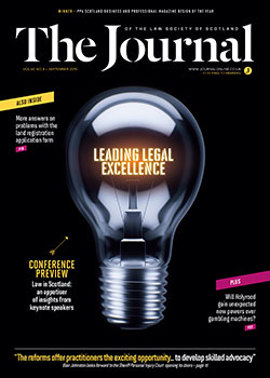Land, leases and LBTT

Property
Land and buildings transaction tax (LBTT) was introduced in Scotland on 1 April 2015 by the Land and Buildings Transaction Tax (Scotland) Act 2013 to replace stamp duty land tax (SDLT). Schedule 19 to the 2013 Act sets out the provisions relating to lease transactions. Transitional rules are set out in the Land and Buildings Transaction Tax (Transitional Provisions) (Scotland) Order 2014.
It is fair to say that the treatment of leases under SDLT was problematic from the start. Scotland, in particular, experienced difficulties with the application of SDLT legislation due to the differences in property laws, leading to many practical “work-arounds” being agreed over the years. Now, six months into the new regime, have there been improvements in the tax system for Scottish tenants and their advisers?
With LBTT, attempts were made to address these issues encountered under SDLT. The resulting regime retains many aspects of SDLT, while introducing new concepts and practices that tenants and their advisers must get to grips with.
While it is not possible to go through all of the LBTT provisions relating to leases in detail, this article examines what transactions are chargeable, when the charge arises, how (and when) to notify and what the tax is paid on.
The tax charge: what is taxable
Most leases of residential property are exempt from LBTT – though the subject matter of the lease transaction must be entirely residential property to qualify (unlike the position in non-lease transactions).
Always assuming it truly is a licence, a licence to occupy premises is exempt from LBTT. Leases granted to certain governmental bodies are also exempt.
Otherwise, as with SDLT, the grant of a lease for a term of seven years or more does not require to be notified where any chargeable consideration, apart from rent, is less than £40,000 and where the “relevant rent” (as defined) is less than £1,000. The grant of a lease of less than seven years must be notified where LBTT is payable, including where a relief is being claimed.
The tax charge: when does it arise?
Generally, liability to make returns and pay tax rests with the tenant. The landlord may require to make a return where consideration is paid for the renunciation of a lease.
Notification and payment of tax to Revenue Scotland (RS) is due within 30 days of the “effective date” and always in advance of submission of a lease for registration.
Care needs to be taken around the grant of a lease, as the trigger point for notification can arise in a number of ways, often without the tenant’s adviser being aware: for example, the last date of execution of the lease, entry or payment of rent, or even when missives are concluded.
Further returns: three yearly cycle
The main difference between SDLT and LBTT is the requirement to notify (and consider the tax liability) throughout the life of the lease under LBTT.
Since the Finance Act 2013, there is no need to consider whether any increases after the fifth year of an SDLT lease are abnormal and, therefore, subject to further notification and tax. By contrast, under LBTT, a tenant under a notifiable lease has to make returns on a three-yearly basis throughout the term of the lease – whether or not there has been any change in the rent. Any failure to make timely returns will result in penalties for the tenant. At present, the form of the three-yearly return is not available.
The advantage of the three-yearly returns is that these will pick up any changes in the rent in the relevant three-year period (rent review or calculation of contingent or turnover rent), the aim being to tax the rent actually paid by the tenant. Such returns and any additional tax due will fall to be made and paid within 30 days of each three-year anniversary.
Additional notification points: assignation and termination
Under SDLT, a return is required at assignation only where sufficient chargeable consideration is given by the incoming tenant.
By contrast, a return will be required by the outgoing tenant in the assignation of an LBTT lease, whether or not there is any consideration being paid. The incoming tenant will then assume responsibility for the three-yearly notification cycle.
As with SDLT, if LBTT was relieved at the initial grant of the lease, an assignation is treated as the grant of a new lease for the remaining term. Unless relief can be claimed, the incoming tenant must make an LBTT return and pay any tax chargeable.
On assignation, it is therefore important for the assignee’s advisers to ensure that they obtain confirmation of the status of the original lease and basis of calculation in the initial return.
If the lease was notifiable for LBTT purposes, a tenant also requires to notify when the lease ends, again in order to avoid a penalty.
RS will not issue any reminders to the tenant to make returns. Advisers will need to consider whether they wish to accept any responsibility for ongoing requirements of tenant clients to make additional future returns, over what might be a fairly lengthy period of time, and tailor their terms of business accordingly.
Variations and extensions
If an original lease was not originally notifiable but is subsequently varied to extend the term and/or increase the rent payable, a return is required if the effect of the variation is that the lease would have been notifiable if these changes had been effective from the start. In this case, the LBTT is calculated using the rates and bands in effect at the date of original grant. A return is required within 30 days from the date on which the variation takes effect and the lease then enters the administrative regime applicable to notifiable leases.
Although LBTT and SDLT leases cannot be linked to one another, care has to be taken when renewing or extending an SDLT lease as this can bring the varied or extended part under the LBTT charge and notification provisions.
SDLT leases which continue by tacit relocation remain subject to SDLT, with tax paid to HMRC rather than RS.
Leases granted on or after 1 April 2015 that continue by tacit relocation are subject to LBTT. However, unlike the position with a formal variation of an existing lease to extend its term (treated as if it was granted from the start for the whole, extended, term), the lease is treated as extended for one year at a time in addition to the original term. If the lease is already notified, notification continues on the three- yearly basis; if the lease eventually reaches notification and/or tax thresholds, it will become notifiable from that point.
Chargeable consideration
Similar to SDLT, LBTT is initially payable on the net present value of the rent over the entire length of the lease. Rights to break or renew are ignored: if a right to renew is exercised, the extended or new lease may be linked to the existing lease for the purposes of LBTT calculation.
LBTT is payable on the VAT-inclusive rent. If, after grant, the landlord subsequently opts to charge VAT on its property interest, the VAT has to be included by the tenant in the next three-yearly LBTT return. An option to tax could also make a lease which was formerly not notifiable, notifiable.
Although under SDLT, RPI increases are ignored, under LBTT these will be picked up by the three-yearly reviews and tax paid on the increases.
LBTT is also chargeable on any premium paid at the same rates and bandings as in a purchase transaction. As with SDLT, where a premium is paid for the grant of a lease and the annual rent is £1,000 or more, the nil rate band is withdrawn and LBTT is charged on the premium.
Other consideration
There are a number of similarities with SDLT here. Any non-monetary consideration “paid” for the lease must be taken into account at market value, and there are also “deemed market value” provisions on transactions where the tenant is a company connected to the landlord. Reverse premia are not chargeable to LBTT.
There is no definition of “rent” in the 2013 Act, so any inclusive single sum expressed as “rent” will be chargeable: if the rent includes other payments such as maintenance or insurance costs, these should be separately stated so as to avoid inclusion in the tax charge.
Reliefs
Assuming all qualifying conditions are met, available reliefs include sale and leaseback, group and charities reliefs. Care should be taken as reliefs claimed are liable to withdrawal in certain circumstances.
Where a relief is claimed there is no need for three-yearly reviews – though returns may be required if a relief is withdrawn or no longer applicable, or where the lease is assigned or brought to an end.
In transition
Although we are already six months into the new LBTT regime, it is fair to say that there are a number of leasing matters that are still unclear. The most important point from the new rules is the requirement on tenants to make returns on a three-yearly basis and on assignation and at termination.
Responsibilities for returns will need to be carefully managed by tenants’ advisers, particularly where the tenant is used to the SDLT regime or operates cross-border. With large numbers of SDLT leases still in play, transitional rules are still very relevant and the position on a number of lease transactions may not be straightforward for tenants and their advisers for some time to come.
In this issue
- Good health – fair question?
- Time to raise the age of criminal responsibility
- Adoption of foreign children – a clash of cultures?
- Presumed liability: the case for action
- Le Bief Bovet: 700 years of litigation
- Reading for pleasure
- Opinion: James O'Reilly (fuller version)
- Opinion: James O'Reilly
- Book reviews
- Profile
- President's column
- Land Register completion update
- People on the move
- Conference calls
- A new court rises
- Questions of form
- Charities - why reserves matter
- Place your bets
- Pensions: a formula unravelled
- Whereabouts unknown?
- Lego Man keeps his mark
- The company one keeps
- Scottish Solicitors Discipline Tribunal
- Land, leases and LBTT
- Big budget brief
- Support sought as Napier joins the law clinics
- Public Guardian's fees to increase
- Law reform roundup
- TCPD: the Update way
- How are we doing?
- Thanks, but no thanks
- Ask Ash






